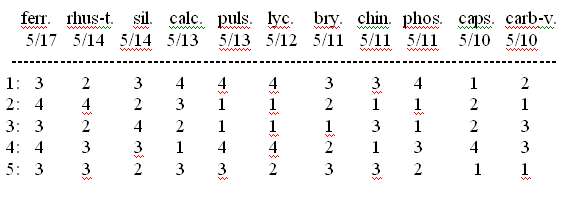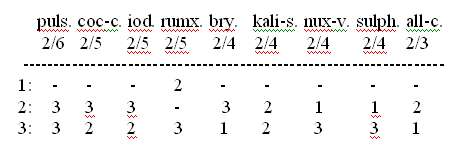I wish I could say this is one of those textbook perfect cases that you see presented at homeopathic conferences where one remedy brings about miraculous cures. I wish I could, but I can’t.
This case is probably more typical of the way most of our cases go – better in hindsight but sufficient in the ultimate resolution.
I was called to consult with a small organic family dairy. The cows on this farm were hand milked twice daily by the father of the family and his son. The father said they were having trouble with a lingering cough in their herd that had proved resistant to the medicines they were using. Being organic, they were prohibited from the use of most pharmaceuticals so had tried some random homeopathic remedies to no avail and were currently palliating the cough with an herbal combination. These herbs were reducing the cough enough to maintain production in the herd but were becoming prohibitively expensive with continued use.
When I took the history of this episode in this herd, I thought it had to be one of the best genus epidemicus cases I had seen. And it was. Unfortunately my first analysis led me astray. But more on that in a bit.
The history of this herd was that several months prior they had developed a serious cough. The cough was harsh enough that it had caused two of the nine cows in the herd to abort. When asked to describe the cough, the farmer was fairly vague about the cough itself as far as describing the nature of the cough other than to say it sounded loose. However he was very precise in the modalities of the cough.
He said that the cough was only noted at the morning milking and only after the cattle got up and started moving toward the barn. The timing of the morning milking had the farmer and the cows on the way to the barn before daylight. It was only when the cattle were roused up and made to move that the cough was heard. Once the cows made it to the barn and were inside the cough stopped.
At the evening milking, no cough was noted either at rest, during motion, inside the barn or out.
Had I been thinking clearly about this case I would have realized that this is just the sort of case that lends itself to analysis through Boenninghausen’s Therapeutic Pocket Book. We had a symptom (cough), modalities (morning before sunrise, on first motion, aggr outside and amel inside), plus a concomitant (abortion). What could be simpler?
With this approach my analysis would have (and should have) looked like this:
1 Parts of the body and organs – Cough – expectoration; with 106
2 Change of general state – Aggravation – time; according to the – midnight – after 75
3 Change of general state – Aggravation – open air; in 107
4 Change of general state – Aggravation – motion; from – beginning of motion; at 36
5 Parts of the body and organs – Menses – abortion 45
2 Change of general state – Aggravation – time; according to the – midnight – after 75
3 Change of general state – Aggravation – open air; in 107
4 Change of general state – Aggravation – motion; from – beginning of motion; at 36
5 Parts of the body and organs – Menses – abortion 45

Given this analysis, I would have read Ferrum and would have found my herd in this remedy. In Hering’s Guiding Symptoms we find a loose cough in the early morning and various aggravations in open air in Ferrum. In Clarke’s Dictionary we find a tendency to miscarriages and a general aggravation on motion and with sudden motions, as well as a general aggravation at midnight and early morning.
Everything in this case is contained in this remedy and it should have been a good fit for the herd. Except it wasn’t given. So we will never know if it was a good fit or not, since the remedy I chose forever changed the case before we had a chance to administer Ferrum. All I know is that this would have been an excellent case with which to use this analysis technique.
But all was not lost just because I chose to analyse the case differently.
This is what actually happened.
I thought the symptom of a violent cough causing an abortion was significant – over the top, strange, peculiar, unexpected.
So I used a Kentian type analysis that emphasized this symptom and, in doing so, violated my rule about not using such small rubrics (Female Genitalia – Abortion – cough agg – 3 remedies). Typically I don’t use a rubric this small and limiting because it does have the potential of weighing your case and swaying it in the wrong direction. But I thought this symptom was just so strange that I had to use the rubric.
My Kentian analysis on Radar looked like this:
- FEMALE GENITALIA/SEX - ABORTION – cough agg. 3
- COUGH – MORNING – waking; on 42
- COUGH – MOTION – agg. 66
- COUGH – AIR; IN OPEN - agg. 63

In Rumex I found not only the abortion from coughing, but also an early morning (4AM) aggravation and on waking, cough induced by deeper respiration, aggravation on walking, and a sensitiveness to open air.
When I read the material medica I thought Rumex was an excellent fit and the fact that it contained abortions from harsh coughs really sold me on the remedy selection.
We treated the herd with Rumex 30c at weekly intervals by mixing the pellets in water and dosing each cow orally.
After the second dose, thinking it would take 2-3 doses of the herd for the entire herd to respond to the remedy (the problem with treating a multi-patient herd is that you have to treat based on the average patient and continue treatment until the process is resolved in the collective), the farmer called to tell me the remedy was not exactly working like we wanted.
When asked to explain, he said that the cattle were still coughing in the mornings only but now, instead of coughing when first moving and only when outside, they were now only coughing when inside the barn.
Rumex was obviously the wrong remedy but the change in the modalities of the cows pointed us to the correct remedy for the time.
I based my next analysis on these changed symptoms (although I probably didn’t really need to do an analysis at this point). This analysis looked like this:
1 FEMALE GENITALIA/SEX – ABORTION – cough agg. 3
2 COUGH – AIR; IN OPEN – amel. 37
3 COUGH – MORNING 195
2 COUGH – AIR; IN OPEN – amel. 37
3 COUGH – MORNING 195

From here Pulsatilla was an obvious and easy choice – even if it did not contain the previously coveted symptom of abortion from cough.
The cattle were dosed with a Pulsatilla 30c once and the cough resolved within the next week in all the cows.
I came away from this case with several lessons.
First I learned to pay more attention to analysis techniques beyond the Kentian approach. This was a case that lent itself very well to Boenninghausen’s approach. I honestly think this approach would have brought this case to resolution on the first remedy.
Secondly, missing the remedy the first time is not the end of the world (or the end of the case). The only thing that an incorrect remedy means is that we really need to pay attention to the patient and follow the changes they are showing. The patient will always point the way to the best remedy through the symptoms they produce.
And finally, this case confirmed what a good match homeopathy is for organic livestock production. After months of herbal treatment and the high cost of these herbs, this case was brought to resolution for just a few dollars and was kept within the bounds of the National Organic Standards by not having to resort to pharmaceuticals.
Actually there was another lesson learned. We as homeopaths don’t have to be perfect – we just have to be persistent.
Author: Glen Dupree, DVM is a veterinary homeopath in St. Francisville, Louisiana, USA. He is author of "Homeopathy in Organic Livestock Production".
Source: Hpathy
Source: Hpathy
No hay comentarios:
Publicar un comentario